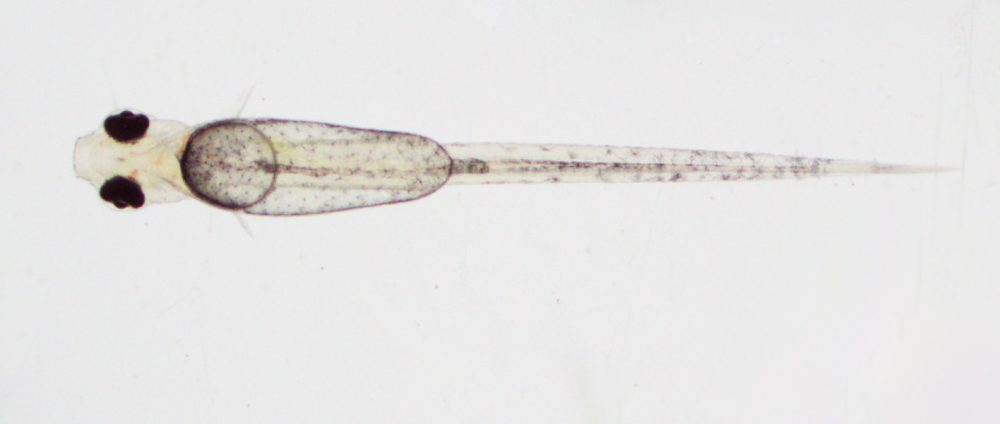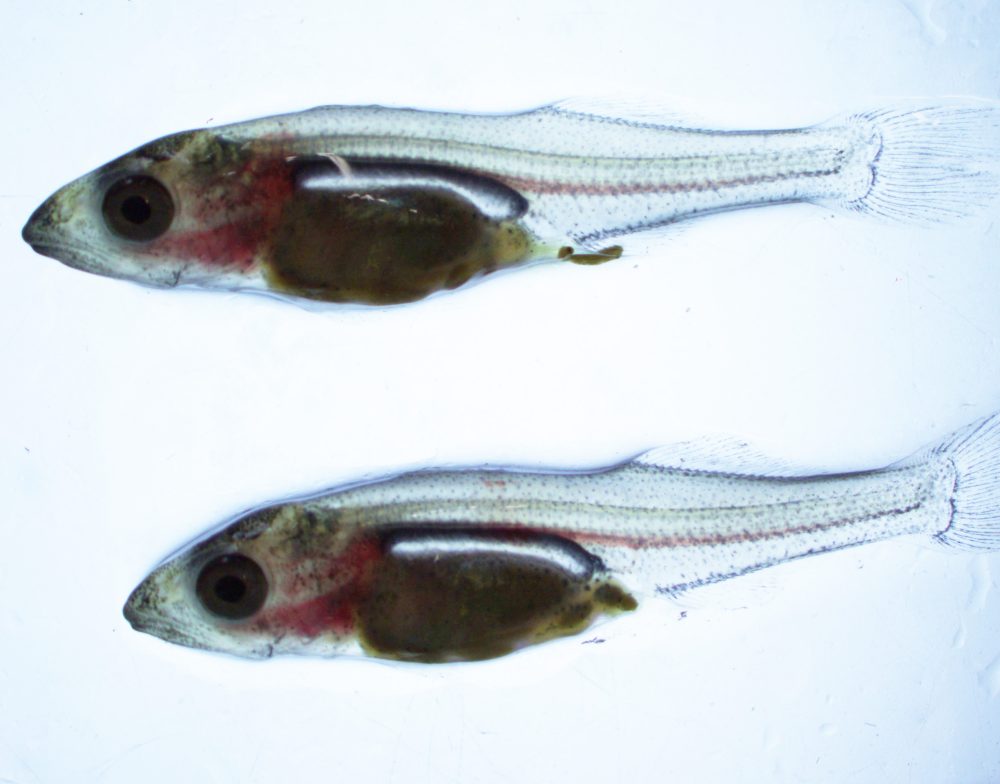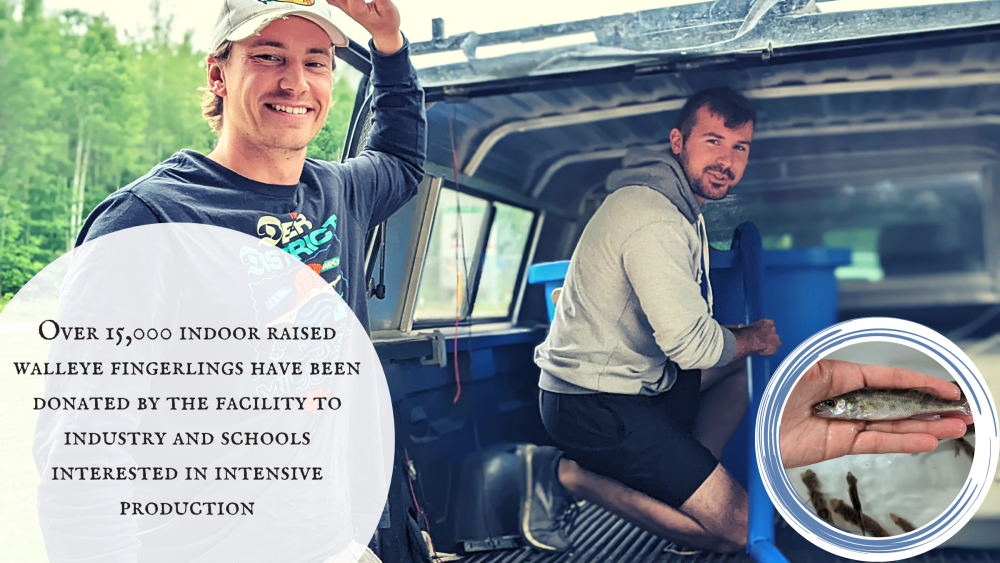Application of Bile Acids to Improve Larval Fish Production
FUNDED BY: THE NORTH CENTRAL REGIONAL AQUACULTURE CENTER
UWSP NADF and partners at UW-Milwaukee School of Freshwater Sciences have been funded to investigate the potential for optimizing larval walleye (shown below) and yellow perch production by incorporating bile acids into larval diets.
 Recently hatched walleye fry at UWSP NADF
Recently hatched walleye fry at UWSP NADF
THE CHALLENGE IN LARVAL DIETS
Providing essential nutrients to larval fish through exogenous feeding represents a formidable task for hatchery management. Presently, due to the limited availability of formulated feeds, the industry heavily relies on live or fresh food to nourish many species of larval fish, despite the associated drawbacks. Challenges with live feeds include substantial costs, seasonal availability constraints, inconsistencies in quality, quantity, size, nutrition and may pose biosecurity risks.
FORMULATED FEEDS
In contrast to live food, formulated feed offers ease of management and control over biosafety, reliable supply, and nutrient quality. However, formulated feeds are not universally effective for all species due to specific feeding behaviors and physiological limitations. Despite extensive research efforts aimed at developing formulated feeds for larval fish, achieving success has proven challenging, primarily owing to our incomplete understanding of the nuanced nutrient requirements for larval fish and the intricate nature of processing micro diets. Although a suitable larval feed has been eventually found, the industry still relies on a single imported diet for percid larviculture making it susceptible to issues such as import bans.

In summary, larval feeds must possess attributes such as attractiveness for feeding, proper density, and particle size for ease of consumption, good water stability to prevent nutrient leaching, high content of essential nutrients for growth, and resilience to supply disruptions.
Currently, co-feeding live foods with imported formulated feeds is a common practice in fish hatcheries for larval rearing. However, the development of domestic feeds to support larval and fingerling rearing remains insufficient for many aquaculture species, including walleye and yellow perch. Even commonly used live feeds like Artemia and commercial feeds fail to provide critical nutrients at all stages of larval development. Larval fish’s limited digestive capacity renders them susceptible to nutrient deficiencies despite a theoretically balanced diet. Thus, it is imperative to supplement these nutrients through enriched formulated larval feed, thereby ensuring nutrient availability for larval fish throughout all stages of development.
THE USE OF BILE ACIDS
Bile acids, in conjunction with their derivatives referred to as bile salts, constitute the fundamental components of bile. They play a pivotal role in a variety of critical biological functions, particularly in lipid metabolism and the maintenance of cholesterol homeostasis. Bile salts, which are water-soluble and possess amphipathic properties, serve multiple essential functions including facilitating the absorption of lipids within the intestines, enhancing the enzymatic breakdown of dietary proteins, and exhibiting potent antimicrobial activity in the small intestine. Beyond their influence on lipids, bile salts also enhance the digestion and assimilation of dietary proteins. They also play a role in regulating various facets of host energy management, immune responses, and intestinal equilibrium and additionally contribute to the upregulation of protein synthesis in skeletal muscle.
The potential of bile acids and bile salts as natural enhancers of growth and health has been demonstrated in feeding trials involving various species of production animals. In aquaculture settings, the utilization of bile acids and bile salts has proven effective in enhancing feeding efficiency, promoting intestinal and liver health, improving growth performance, and regulating glucose metabolism across different species. Consequently, we hypothesize that incorporating bile acids into fish larval feed holds tremendous potential for enhancing the health and growth of fingerling production.
THE RESEARCH
This project aims to enhance larval feed nutrition by incorporating locally generated bile acids, focusing on improving production capacity for yellow perch (Perca flavescens) and walleye (Sander vitreus). To achieve this goal, a series of test diets supplemented with bile acids (ranging from 0 to 800 mg/kg diet) will be developed and fed to perch and walleye larvae during the initial 35 days post-hatch. Walleye will be cultured at UWSP NADF while the yellow perch cultured at UW-Milwaukee School of Freshwater Sciences. The optimal level of bile acid supplementation will be determined based on survival, growth, nutrition, fish health, and metabolism analyzed through metabolomic techniques.
THE IMPACTS
 UWSP NADF continues to work with industry partners looking to raise walleye intensively including providing technical assistance, training and donation of fry and fingerlings.
UWSP NADF continues to work with industry partners looking to raise walleye intensively including providing technical assistance, training and donation of fry and fingerlings.
Applied research will be conducted at commercial farms to validate the laboratory findings and provide training to farmers. The findings will be disseminated through various outreach activities, including training workshops, and publishing papers or articles in professional journals and community websites/magazines. These efforts will benefit the yellow perch and walleye aquaculture sector by ensuring a reliable supply of high-quality fingerlings.